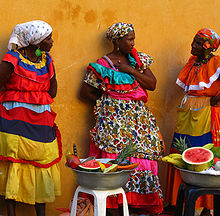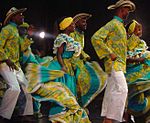History
See also: Slavery in Colombia
“Fiesta in Palenque” traditional African Colombian dance from San Basilio de Palenque, a former enclave, now considered by the UNESCO a Masterpieces of the Oral and Intangible Heritage of Humanity.
Africans were taken to Colombia as slaves in the beginning of the 16th Century, from places such as modern day Congo, Angola, Gambia, Nigeria, Cameroon, Liberia, Ghana, Ivory Coast, Guinea, Sierra Leone, Senegal and Mali[4] to replace the rapidly declining Native American population. African slaves were forced to work in gold mines, on sugar cane plantations, cattle ranches, and large haciendas. African labor was essential in all regions of Colombia, leading into modern times. African workers pioneered the extraction of alluvial gold deposits and the growing of sugar cane in the areas that correspond to the modern day departments of Chocó, Antioquia, Cauca, Valle del Cauca, and Nariño in western Colombia.
In eastern Colombia, near the cities of Vélez, Cúcuta, Socorro and Tunja, Africans manufactured textiles in commercial mills. Emerald mines outside of Bogotá relied on African laborers. Other sectors of the Colombian economy, like tobacco, cotton, artisanry and domestic work would have been impossible without African labor. In pre-abolition Colombian society, many Afro-Colombian captives fought the Spanish and their colonial forces for their freedom as soon as they arrived in Colombia.
Those who escaped from their oppressors would live in free Black African towns called Palenques, where they would live as Cimarrones. Some historians consider Chocó to be a very big palenque, with a large population of Cimarrones, especially in the areas of the Baudó River. Cimarrón leaders like Benkos Biohó and Barule fought for freedom. African people played key roles in the struggle for independence from Spain. Historians note that three of every five soldiers in Simon Bolívar‘s army were African[5]. Afro-Colombians were able to participate at all levels of military and political life.
In 1851, the life of Afro-Colombians was very difficult. Afro-Colombians were forced to live in the jungles for self-protection. There, they learned to have a harmonious relationship with the jungle environment and share the territory with Colombia’s indigenous people.
From 1851, the Colombian State promoted the ideology of mestizaje, or miscegenation. In order to maintain their cultural traditions, many Africans and indigenous peoples went deep into isolated jungles. Afro-Colombians and indigenous people were often targeted by armed groups who wanted to displace them in order to take their land for sugar cane plantations, coffee and banana plantations, mining and wood exploitation. This form of discrimination still occurs today.[6]
In 1945 the department of El Chocó was created, the first predominantly African political-administrative division in the country. El Chocó provided the possibility of building an African territorial identity and some autonomous decision-making power.[7]


